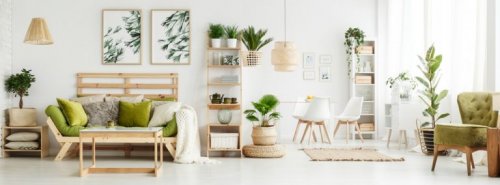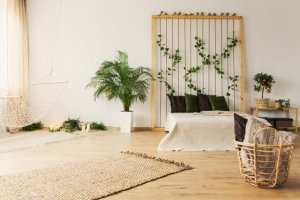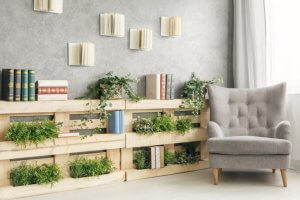The Slow Design Decorative Style

You might say that the Slow Design style is the opposite of our current society. Our days are filled with rushing, traffic jams, stress, and noise, but this decorative style’s mission is to help you calm down.
Entering a house decorated with a Slow Design style means entering a haven of peace and tranquility. A place where nature, silence, and relaxation will free you from the stress you accumulate throughout the day.
If you want to experience these same feelings when walking into your own home, then we’ll tell you the keys to this kind of decoration. You should also know that Slow Design is far more than just decorating, it’s a lifestyle. People with this philosophy of life not only use it to decorate their homes, but they also incorporate it into their diets.
Natural elements: Slow Design style
Nature plays an important role in Slow Design decoration and is essential for creating a sense of tranquility, peace, and calm. Among the materials you can use, wood is fundamental: doors, tables, chairs, floors. Make sure the wood is untreated, otherwise you’ll lose the natural effect.

These elements also give your home the feeling that time has stopped when you enter it. Stress and haste stay outside while inside the priorities are rest, a relaxed life and family.
Minimalist decoration
Slow Design houses have minimalist decor. Use natural objects and earthy colors to decorate rooms, and make sure you don’t overfill the space.

You want wide and visually clean spaces.
Decorate with natural elements that have some kind of meaning.
Look for elements that you can decorate with, but that also have meaning. Second-hand or recycled objects are perfect for this decorative style and go great with the slow lifestyle. Remember to get rid of any objects that are made of plastic or a similar material.
Plants are another great example of minimalist decoration. Choose two or three bright and large interior pots to decorate the room and bring you closer to nature.
Open spaces
The Slow Design style puts a lot of emphasis on nature, so the home’s exterior is important. Porches, terraces, and gardens must be cared for and furnished so that you can fully enjoy them. Some suggestions are a stone garden, a fountain or a seating area where you can spend time with the family. Just like with the rest of the rooms, make sure you leave ample space and you choose comfortable furniture.

Another option is to take advantage of open spaces by creating thematic corners. This could be a space for reading, games or just a chill out area. But remember not to put too many decorative elements in one place and keep the furniture is as natural as possible.
Glass doors and walls are the perfect way to connect the open spaces of the house. This will give the area a sense of continuity. This will also make the home’s exterior look like part of the room while also making it look brighter and wider.
You might say that the Slow Design style is the opposite of our current society. Our days are filled with rushing, traffic jams, stress, and noise, but this decorative style’s mission is to help you calm down.
Entering a house decorated with a Slow Design style means entering a haven of peace and tranquility. A place where nature, silence, and relaxation will free you from the stress you accumulate throughout the day.
If you want to experience these same feelings when walking into your own home, then we’ll tell you the keys to this kind of decoration. You should also know that Slow Design is far more than just decorating, it’s a lifestyle. People with this philosophy of life not only use it to decorate their homes, but they also incorporate it into their diets.
Natural elements: Slow Design style
Nature plays an important role in Slow Design decoration and is essential for creating a sense of tranquility, peace, and calm. Among the materials you can use, wood is fundamental: doors, tables, chairs, floors. Make sure the wood is untreated, otherwise you’ll lose the natural effect.

These elements also give your home the feeling that time has stopped when you enter it. Stress and haste stay outside while inside the priorities are rest, a relaxed life and family.
Minimalist decoration
Slow Design houses have minimalist decor. Use natural objects and earthy colors to decorate rooms, and make sure you don’t overfill the space.

You want wide and visually clean spaces.
Decorate with natural elements that have some kind of meaning.
Look for elements that you can decorate with, but that also have meaning. Second-hand or recycled objects are perfect for this decorative style and go great with the slow lifestyle. Remember to get rid of any objects that are made of plastic or a similar material.
Plants are another great example of minimalist decoration. Choose two or three bright and large interior pots to decorate the room and bring you closer to nature.
Open spaces
The Slow Design style puts a lot of emphasis on nature, so the home’s exterior is important. Porches, terraces, and gardens must be cared for and furnished so that you can fully enjoy them. Some suggestions are a stone garden, a fountain or a seating area where you can spend time with the family. Just like with the rest of the rooms, make sure you leave ample space and you choose comfortable furniture.

Another option is to take advantage of open spaces by creating thematic corners. This could be a space for reading, games or just a chill out area. But remember not to put too many decorative elements in one place and keep the furniture is as natural as possible.
Glass doors and walls are the perfect way to connect the open spaces of the house. This will give the area a sense of continuity. This will also make the home’s exterior look like part of the room while also making it look brighter and wider.







